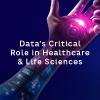Industry
The status quo is changing for most industries as boundaries blur between fields due to innovation, disruption, and digitally-driven change. That’s why keeping abreast of emerging trends in sectors outside your own is vital, not only because your organization’s competitive landscape may be changing, but because there are universal, strategic lessons to learn from the opportunities and threats convergence poses for every marketplace. We examine emerging trends and the impact of evolving tech in key fields such as healthcare, financial services, telco, energy, mobility, and more to help you capitalize on the possibilities of the future while managing the challenges of today.
Insight
Cutter Expert Curt Hall explains how machine vision systems using machine learning (ML) and other artificial intelligence techniques are gradually spreading from use in large auto manufacturers to being incorporated in aftermarket businesses. Increased accuracy of ML-based cameras, edge computing systems, machine vision startups targeting the market, and MaaS are all driving the expansion. One main area of use, Hall explains, is in camera-based robotic systems to automate basic maintenance operations like tire changing. Another area is automated vehicle inspection that can be used by repair shops, dealership service departments, online vehicle marketplaces and auction sites, and auto parts recyclers. Hall says the trend is just getting under way, so we’ll see a steady rise in the use of these systems in the near future.
Ralph Menzano takes us on a fascinating journey into the world of smartphone-based tolling — a way to increase road-based revenue, help cities control peak-time congestion, and (at long last) enforce HOV lane use. Next-gen toll systems not only cost less than RFID-based ones, but have the potential to reduce the number of cars on the road, replace gas-tax revenue lost due to EVs, and provide a mountain of information to transit authorities to help them better manage traffic. Menzano offers a success story from a pilot program in Texas, USA; looks at how the US has fared against Europe and Asia in tolling; and helps us understand why much of the world is looking to the US for leadership in usage-based road pricing for light vehicles.
Cutter Expert San Murugesan says now is the time to examine the potential effect of autonomous vehicles (AVs) on climate change so we can take appropriate steps before widespread adoption is upon us. We need to examine the potential positive and negative environmental impacts of AVs, look at whether they can help reduce the transport sector’s carbon emissions, and consider how we can minimize their carbon footprint as they become mainstream. After explaining the six levels of automation, Murugesan describes several potential AV benefits, including fewer road accidents, making elderly populations more mobile, and solving the last-mile-delivery dilemma with autonomous trucks. After a careful examination of the possible environmental impact of AVs, he offers recommendations for creating an autonomous future that will not only be safer and more convenient, but also better for the environment.
As we explore in this Advisor, machine vision systems employing machine learning and other artificial intelligence techniques are now bringing major benefits to automakers, dealers, and repair shops in the form of camera-based automated vehicle inspection systems.
Saeed Rahman, Natalie Slawinski, and Monika Winn examine how pioneering companies in agriculture, agri-food, and other sectors can build and leverage ecological knowledge (knowledge about the very ecosystems they rely on) to develop innovative practices that help regenerate social and natural systems. In doing so, these companies can reap benefits for their business and help turn our unsustainable agricultural systems into systems that sustain a growing human population without severely degrading or destroying ecological systems necessary for agriculture and other industries.
The theme of this issue of Amplify is quite specific, yet very broad. The contributions cover disparate topics that are all very appropriate under the theme. There are some common threads, though, and recognizing these will help governments, organizations, and individuals understand the many facets of “data” in the large and complex healthcare space and act accordingly.
Curt Hall focuses on the benefits of integrating unstructured data into electronic health records. He describes how biometric data, lifestyle data, and general healthcare information can come together to help clinicians, researchers, and health/wellness companies better understand the effect of patient health behaviors and lifestyles on potential approaches and treatments. More personalized medical treatments, improved health trend identification, and lower healthcare costs are all possible outcomes.
Five Arthur D. Little Partners and Principals predict that big data will move the healthcare industry’s digital transformation forward, providing better admission rate estimation, more effective chronic-care treatments, and a reduction in medication-error rates. Their article includes detailed descriptions of eight drivers of data-driven healthcare: technology trends, data quality and availability, data security, an enabling ecosystem, public-private partnerships, patient participation, the need for better change management, and the development of employees with data analysis skills.





















